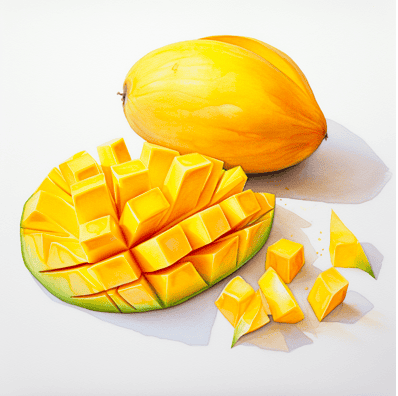
Whether you have whole mangoes, sliced mango or dried mango, you’ll see how to tell if mango is bad below.
Hi, I’m Hazel
I gave up on skincare after years of issues with acne and sensitive skin.
But after going plant-based, my skin cleared up and even started to glow. Now I help women reveal their natural beauty with simple, delicious plant-based food.
I also used to be a nurse, and love nerding out on nutritional science (high-quality science, that is).

As usual, this post is based on the strongest nutritional evidence I could find with a focus on the simplest, most delicious foods
…because who has time to waste on actions that don’t work?
The quick version:
To tell if a mango is bad, inspect its appearance for any unusual spots or mould, check the texture for excessive softness or hardness, and smell for any off odours. These simple sensory checks will help you quickly identify whether a mango is fresh and ripe or should be avoided for consumption.
Identifying a Spoiled Mango – Uncut Mangoes
The journey to a perfect mango experience starts with your senses. Paying close attention to the mango skin, the mango’s texture, and overall appearance are your first lines of defence against bad fruit.

Appearance
The skin of the mango can tell you a lot.
Healthy mangoes often display a vibrant, unblemished skin, but when you start seeing brown spots, white spots, or pink spots, consider these as warning signs.
These discolourations, especially when they’re widespread or accompanied by other symptoms, can indicate underlying issues.
Texture
One of the most telling factors is the texture.
A good mango should be firm yet yield slightly under pressure, indicative of a perfectly ripe mango.
If the fruit feels overly mushy or unusually hard, it could be an overripe mango or an unripe mango, respectively.
Either scenario is less than ideal and suggests that the mango might not provide the best eating experience.
Smell
Lastly, the smell can guide you.
Ripe mangoes exude a sweet scent, inviting and unmistakable. If a mango smells sour or fermented, it’s past its prime and likely harbouring undesirable qualities that could impact taste and health.
By keeping these factors in mind, you can avoid the common pitfalls of selecting mangoes and ensure that each piece you choose is as delicious and healthful as possible.
Sliced Mangoes
Once a mango has been cut, it’s crucial to assess its quality before consuming. Mango pieces that have been sliced should still adhere to quality standards to ensure they’re safe and enjoyable to eat.

Visual Signs
Inspect the flesh of a mango when it’s cut.
Look for any unusual colour changes such as brown flesh, which is often a sign of oxidation or spoilage.
Additionally, a slimy film on the surface of the mango pieces is a clear indicator that the mango should not be consumed.
Odour and Taste
The freshness of cut mango can also be gauged through its smell and taste.
If the mango pieces emit an off smell or the flavour is notably sour or fermented, these are signs that the mango is no longer in its prime condition.
Being diligent about inspecting cut mangoes can help ensure that every bite is as fresh and delicious as intended, keeping health risks at bay.
Frozen Mangoes
Frozen mangoes offer a convenient way to enjoy this versatile fruit year-round, but like all frozen fruits, they can still go bad if not handled or stored properly.

Texture and Colour Changes
One of the first signs of spoilage in frozen mangoes includes the presence of ice crystals or a look of freezer burn.
These signs usually indicate that the mango has been stored for too long or has been thawed and refrozen, which can significantly alter its texture and flavour.
Smell and Taste
Upon thawing, give the mango a sniff and a small taste.
Any unusual odours or off flavours are immediate indications that the mango should not be consumed.
A fresh, properly frozen mango will retain the sweet scent and taste characteristic of a perfectly ripe mango.
Understanding how to determine the quality of frozen mangoes can save you from a disappointing culinary experience and ensure that your dishes maintain the desired nutritional value and taste.
You might also like:
Preserving Summer: How Can You Freeze Lychee?
Dried Mangoes
Dried mangoes are a popular, convenient snack, offering a longer shelf life and a different texture from their fresh counterparts. However, even dried mangoes can deteriorate over time.

Texture and Appearance
Normally, dried mangoes should be chewy but not rock-hard.
When you find that the texture of the dried mango pieces has become overly hard or if there is visible discolouration or mould, these are clear signs that the dried mangoes are not suitable for consumption.
Smell
A fresh, good-quality dried mango will have a mildly sweet and fruity aroma. If the dried mangoes emit a musty or overly fermented smell, it’s an indication that they have gone bad and should be avoided.
By keeping an eye on these aspects, you can ensure that your dried mangoes are still good to eat and free from any signs of spoilage.
How to Properly Dispose of Spoiled Mangoes
Even with the best efforts, some mangoes may go bad.
Proper disposal is important to prevent waste and utilise eco-friendly practices.
- Composting: Spoiled mangoes make excellent additions to compost because they break down quickly and enrich the soil with nutrients. Adding mango waste to a compost bin is a great addition to any eco-conscious effort.
- Preventing Fruit Flies: To avoid attracting fruit flies, ensure that any spoiled mangoes are disposed of promptly and securely. Use a sealed bag or compost them immediately to minimise exposure and maintain a clean kitchen environment.
How to Keep Mangoes Fresh Longer
Proper storage is key to maintaining the freshness and extending the shelf life of mangoes, whether they are fresh, cut, or dried.
Fresh and Whole Mangoes
Store whole mangoes at room temperature away from direct sunlight until they ripen.
Once ripe, mangoes can be moved to the refrigerator to slow down any further ripening.
This similar process can also apply to cut mangoes, which should be kept in an airtight container in the fridge.
Dried Mangoes
Dried mangoes should be kept in a cool, dry place in an airtight container to prevent them from absorbing moisture and becoming mouldy. For extended storage, placing them in the refrigerator can help maintain their quality longer.
Following these tips ensures that each type of mango retains its best quality and nutritional benefits for as long as possible.
Ripeness Indicators
Understanding the different types of mangoes can enhance your ability to pick the best fruit and appreciate the unique qualities each variety offers.
Variety Characteristics: Each type of mango has distinct features. For instance, green mangoes are often used unripe for their tartness in various dishes, while yellow mangoes are typically sweeter and softer when ripe.
Ripeness Indicators: For most varieties, a gentle squeeze can help determine ripeness. A perfectly ripe mango will yield slightly under pressure, indicating it’s ready to eat. The absence of this give in whole mangoes might suggest they are still unripe mangoes. Conversely, if the mango feels too soft, it may be an overripe mango.
This knowledge not only helps in selecting the best fresh mangoes but also enhances your enjoyment and appreciation of this delicious fruit.
How to tell if a mango is bad
Selecting and storing mangoes properly requires a keen sense of observation and a bit of knowledge. Remember the signs of spoilage—discolouration, unpleasant odours, and inappropriate texture—and trust your senses to guide you. By applying these insights, you can enjoy mangoes at their peak taste and nutritional value, ensuring they contribute positively to your health-conscious lifestyle. Your understanding of how to tell if mango is bad will lead to better choices in the kitchen and the grocery store, enhancing your enjoyment of this delicious fruit.
References
Most references below will link to the original peer-reviewed study itself. However, sometimes I will link to a video over at NutritionFacts.org instead, which is by far the single best resource of brutally transparent nutritional evidence you will ever see. Dr Greger tells a great story about the realities of the science and if I think you will benefit more from one of his videos, the link will take you there instead.
Happy nerding!